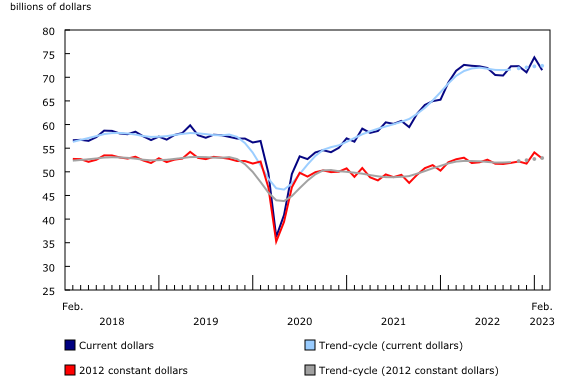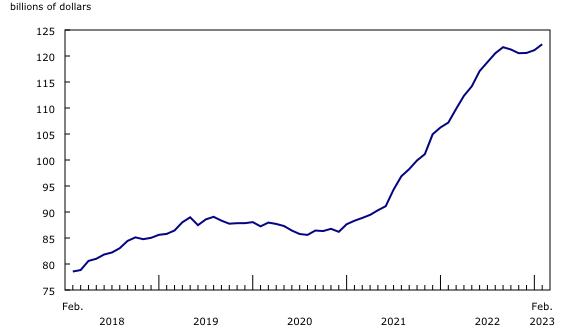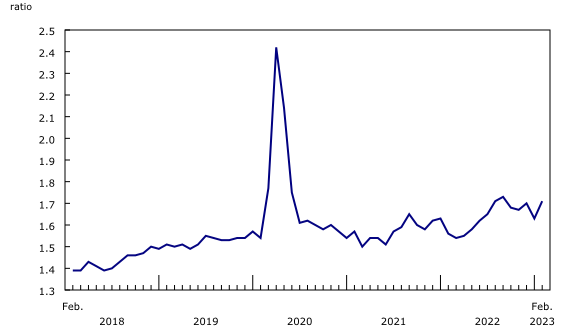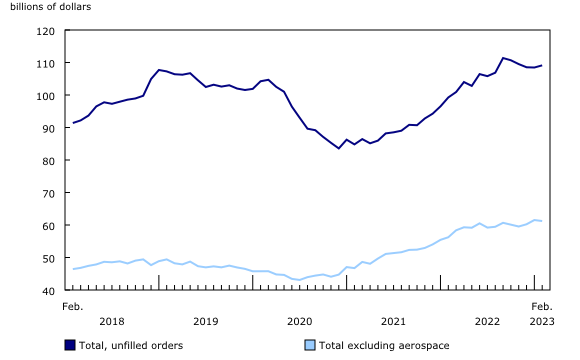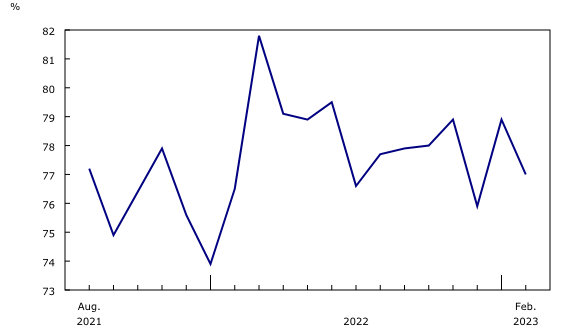Monthly Survey of Manufacturing, February 2023
Released: 2023-04-14
Canadian manufacturing sales declined 3.6% to $71.5 billion in February, following a 4.5% increase in January. The decreases were observed in 12 of 21 industries, led by the petroleum and coal product (-14.9%), motor vehicle (-12.3%) and primary metal (-4.2%) industries. Conversely, the machinery (+3.0%) and electrical equipment, appliance and component (+6.0%) industries posted the largest increases. Year over year, total sales were up 3.8% in February.
The monthly decline resulted from lower volumes and prices as sales in real terms decreased 2.4% in February and the Industrial Product Price Index edged down 0.8%.
Petroleum and coal products drive the decline
Following a strong growth in January, sales of petroleum and coal products fell 14.9% to $8.8 billion in February, marking the third-largest monthly decline in dollar terms on record. Sales volumes were down 8.3%. Prices (-6.4%) and exports (-12.8%) of refined petroleum energy products (including liquid biofuels) fell considerably month over month. Maintenance turnaround as well as lower demand for heating fuel likely due to mild weather in most of Europe and the United States could be partly responsible for the monthly declines. Year over year, sales edged down 0.8% in February.
After three consecutive monthly increases, sales of motor vehicles were down 12.3% to $4.2 billion in February, driven by reduced production associated with insufficient supply of chips and materials. Fewer calendar days in February compared with January also had a role in the decrease. Sales of motor vehicle parts edged up 0.3% in February, the slowest monthly growth rate in five months. Exports of motor vehicles and parts fell 4.4%. Despite the monthly decrease, sales of motor vehicles were up 9.5% in February compared with the same month last year.
Sales of primary metals declined 4.2% to $5.6 billion in February, following a 4.4% increase in January, with decreases spanning all five primary metal industries. The non-ferrous metal (except aluminum) production and processing industry (-14.7%) led the decline, coinciding with lower prices of primary non-ferrous metal products (-2.4%) in February. Other notable contributors to the monthly decline were related to ferrous metal industries such as the steel product manufacturing from purchased steel (-12.2%) and iron steel mills and ferro-alloy manufacturing (-6.1%) industries. While prices for primary ferrous metal products increased (+1.7%), exports of most unwrought metal products were down in February. Sales in volume terms declined 4.7% month over month, while on a yearly basis, sales in current dollars edged down 1.0% in February.
Machinery industry increases the most
Sales in the machinery industry rose 3.0% to a record-high $4.6 billion in February, the fourth consecutive monthly increase. The gain was broad-based, with elevated sales in five of seven manufacturing industries, led by the industrial machinery manufacturing industry (+18.2%). Year over year, sales increased 20.0% in February.
Sales in the electrical equipment, appliance and component industry increased 6.0% to $1.3 billion in February, mostly attributable to higher sales in the electrical equipment industry. Exports of electrical components rose 1.9% in February.
Sales down in nine provinces, led by Alberta
Manufacturing sales decreased in nine provinces in February, primarily driven by lower sales in Alberta, Ontario and Quebec. Prince Edward Island was the only province where sales were unchanged.
In Alberta, sales declined 9.6% to $8.8 billion in February, after a prominent growth in January. The petroleum and coal product industry (-27.3%) and to a lesser extent, the chemical industry (-8.3%) drove the sales down, whereas the machinery (+12.5%) and fabricated metal (+11.6%) industries led the increase. Despite a monthly decrease, total sales were up 2.5% in February on a yearly basis.
In Ontario, sales were down 2.6% to $31.8 billion in February, mainly on lower sales of motor vehicles (-12.4%), petroleum and coal products (-4.2%) and primary metals (-4.7%). Partially offsetting the decline was higher sales in the electrical equipment, appliance and component industry (+14.3%). Compared with the same month in 2022, total sales increased 7.7% in February.
Sales in Quebec decreased 1.6% to $17.7 billion in February, as lower sales in the transportation (-8.9%) and petroleum and coal product industries were partially offset by higher sales in the chemical (+12.8%) and machinery (+8.4%) industries. On a yearly basis, total sales were up 1.3% in February.
In Prince Edward Island, sales held steady at $274.0 million in February, as increases in the durable goods industries (+10.5%) were offset by decreases in the non-durable goods industries (-4.3%).
Edmonton sales decrease the most
Manufacturing sales fell in 10 of 15 selected census metropolitan areas in February, led by Edmonton and followed by Québec. Meanwhile, sales in Toronto grew the most.
In Edmonton, sales recorded the largest monthly decrease, down 15.1% to $4.1 billion in February, almost entirely driven by lower sales of petroleum and coal products (-26.1%). Despite a monthly decline, total sales were up 1.6% in February compared with the same month of last year.
Sales in Québec were down for the third consecutive month, decreasing 10.8% to $1.9 billion in February, on lower sales of petroleum and coal products. Partly offsetting the drop were higher sales in the beverage and tobacco product industry.
In Toronto, sales increased for the second consecutive month, rising 1.1% to $12.9 billion in February, the highest on record. The monthly gain was primarily on higher sales in the motor vehicle industry (+4.9%), whereas the motor vehicle parts industry (-6.6%) recorded the largest decrease. Year over year, total sales rose 12.4% in February.
Levels of inventory increase to new high
Total inventory levels rose 0.9% to $122.3 billion in February, marking a new record high, with increases in finished products (+1.7%) and goods in process (+1.7%) and little change in raw materials (-0.1%). The petroleum and coal product (+8.8%), aerospace product and parts (+5.4%) and chemical (+2.3%) industries posted the largest gains, while the fabricated metal (-2.8%), wood product (-3.0%) and primary metal (-0.9%) industries posted the largest declines.
The monthly growth of total inventories resulted from higher volumes as total inventory level in real terms grew 1.8% in February, while the Raw Materials Price Index declined 0.4%.
The inventory-to-sales ratio increased from 1.63 in January to 1.71 in February. This ratio measures the time, in months, that would be required to exhaust inventories if sales were to remain at their current level.
Unfilled orders rise
The total value of unfilled orders rose 0.6% to $109.1 billion in February, mainly on higher unfilled orders in the aerospace product and parts, other transportation equipment and railroad rolling stock industries, while the ship and boat building and plastics and rubber products manufacturing industries posted the largest declines. The total value of unfilled orders was up 9.9% on a year-over-year basis in February.
The total value of new orders decreased 2.7% to $72.2 billion in February, with substantial declines in the new orders of petroleum and coal products (-15.5%) and motor vehicles (-15.0%) industries. Meanwhile, the aerospace products and part industry recorded the largest increase.
Capacity utilization rate decreases
The capacity utilization rate (not seasonally adjusted) for the manufacturing sector decreased from 78.9% in January to 77.0% in February, with lower capacity utilization rates in 14 of 21 industries. Notable decreases were in the petroleum and coal product (-5.9 percentage points), transportation equipment (-2.5 percentage points) and primary metal (-3.9 percentage points) industries. The decreases were partially offset by a higher capacity utilization rate in the machinery industry (+1.7 percentage points).
Sustainable development goals
On January 1, 2016, the world officially began implementing the 2030 Agenda for Sustainable Development—the United Nations' transformative plan of action that addresses urgent global challenges over the following 15 years. The plan is based on 17 specific sustainable development goals.
The Monthly Survey of Manufacturing is an example of how Statistics Canada supports the reporting on the global sustainable development goals. This release will be used to help measure the following goal:

Note to readers
Monthly data in this release are seasonally adjusted and are expressed in current dollars, unless otherwise specified.
Seasonally adjusted data are data that have been modified to eliminate the effect of seasonal and calendar influences to allow for more meaningful comparisons of economic conditions from period to period. For more information on seasonal adjustment, see Seasonally adjusted data – Frequently asked questions.
Trend-cycle estimates are included in selected charts as a complement to the seasonally adjusted series. These data represent a smoothed version of the seasonally adjusted time series and provide information on longer-term movements, including changes in direction underlying the series. For information on trend-cycle data, see Trend-cycle estimates – Frequently asked questions.
Both seasonally adjusted data and trend-cycle estimates are subject to revision as additional observations become available. These revisions could be large and could even lead to a reversal of movement, especially for reference months near the end of the series or during periods of economic disruption.
Non-durable goods industries include food; beverage and tobacco products; textile mills; textile product mills; apparel; leather and allied products; paper; printing and related support activities; petroleum and coal products; chemicals; and plastics and rubber products.
Durable goods industries include wood products; non-metallic mineral products; primary metals; fabricated metal products; machinery; computer and electronic products; electrical equipment, appliances and components; transportation equipment; furniture and related products; and miscellaneous manufacturing.
Production-based industries
For the aerospace and shipbuilding industries, the value of production is used instead of the value of sales of goods manufactured. The value of production is calculated by adjusting monthly sales of goods manufactured by the monthly change in inventories of goods in process and finished products manufactured. The value of production is used because of the extended period of time that it normally takes to manufacture products in these industries.
Unfilled orders are a stock of orders that will contribute to future sales, assuming that the orders are not cancelled.
New orders are those received, whether sold in the current month or not. New orders are measured as the sum of sales for the current month plus the change in unfilled orders from the previous month to the current month.
Manufacturers reporting sales, inventories and unfilled orders in US dollars
Some Canadian manufacturers report sales, inventories and unfilled orders in US dollars. These data are then converted to Canadian dollars as part of the data production cycle.
For sales, based on the assumption that they occur throughout the month, the average monthly exchange rate for the reference month established by the Bank of Canada is used for the conversion. The monthly average exchange rate is available in table 33-10-0163-01. Inventories and unfilled orders are reported at the end of the reference period. For most respondents, the daily average exchange rate on the last working day of the month is used for the conversion of these variables.
However, some manufacturers choose to report their data as of a day other than the last working day of the month. In these instances, the daily average exchange rate on the day selected by the respondent is used. Note that because of exchange rate fluctuations, the daily average exchange rate on the day selected by the respondent can differ from both the exchange rate on the last working day of the month and the monthly average exchange rate. Daily average exchange rate data are available in table 33-10-0036-01.
Revision policy
Each month, the Monthly Survey of Manufacturing releases preliminary data for the reference month and revised data for the previous three months. Revisions are made to reflect new information provided by respondents and updates to administrative data.
Once a year, a revision project is undertaken to revise multiple years of data.
Real-time data tables
Real-time data tables 16-10-0118-01, 16-10-0119-01, 16-10-0014-01 and 16-10-0015-01 will be updated on April 21.
Next release
Data from the Monthly Survey of Manufacturing for March will be released on May 16.
Contact information
For more information, or to enquire about the concepts, methods or data quality of this release, contact us (toll-free 1-800-263-1136; 514-283-8300; infostats@statcan.gc.ca) or Media Relations (statcan.mediahotline-ligneinfomedias.statcan@statcan.gc.ca).
- Date modified:



